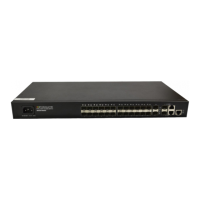EFM configuration
Response timeout configuration
Configure remote failure indication
Configure link
monitoring capabilities
Start link monitoring capabilities
Configure errored-symbol-period event
detection parameters
Configure errored-frame event
detection parameters
Configure errored-frame-period event
detection parameters
Configure errored-frame-seconds event
detection parameters
Configuration far end
loopback function
Reject remote loopback requests
initiated by remote
Initiate a remote loopback request
Configure remote
access function MIB
variable
Start the remote access function MIB
variable
MIB variable access requests initiated
by remote
Display and maintenance of EFM
34.2.2 EFM Basic Configuration
EFM mode of operation is divided into proactive mode and passive mode, when the EFM
function enabled, the Ethernet port started to use the default mode of operation and the
establishment of its peer port connected EFM.
Table 34-4 EFM basic configuration
Enter global configuration
mode
Enter port configuration
mode.
interface ethernet device / slot /
port
Required
By default, EFM is off
efm mode {passive | active}
Optional
By default, EFM mode to
active mode
34.2.3 EFM Timer Parameter Configuration
EFM connection is established, both ends of the EFM entity will be a certain time interval
to send Information OAMPDU cycle to detect whether the connection is normal, the interval is
called the interval to send handshake packets. If one end of the connection timeout EFM
entity within an entity does not receive remote EFM sent Information OAMPDU, EFM is
considered disconnected.

